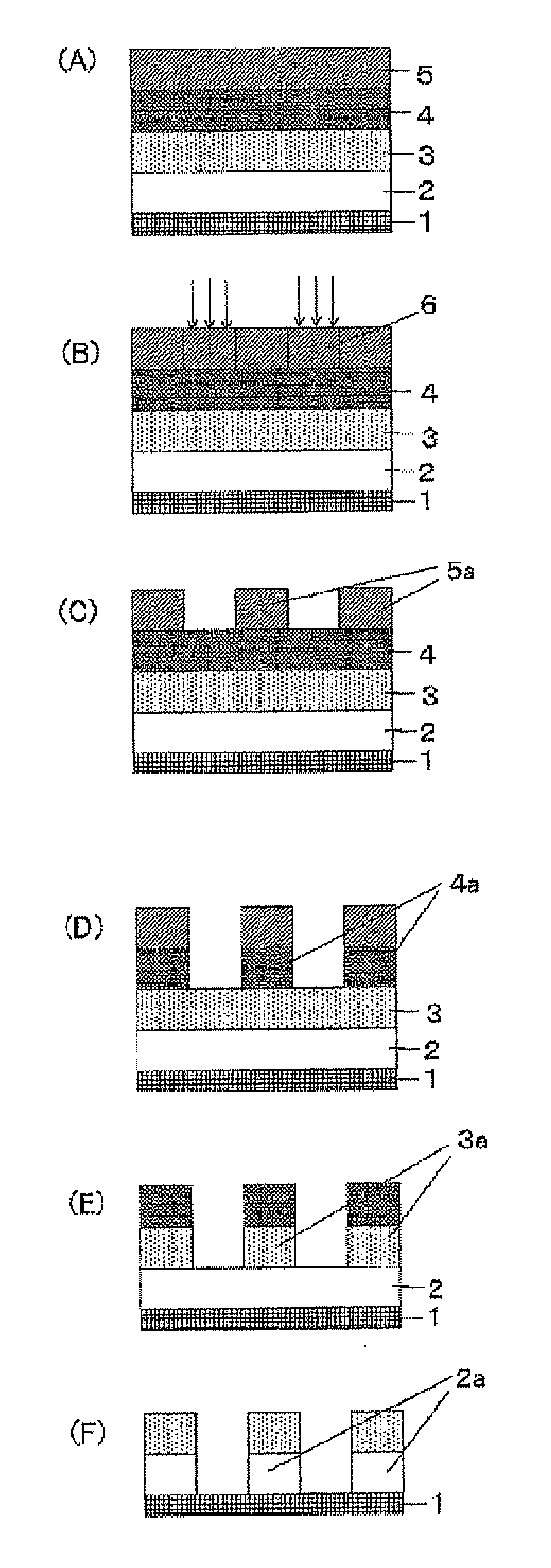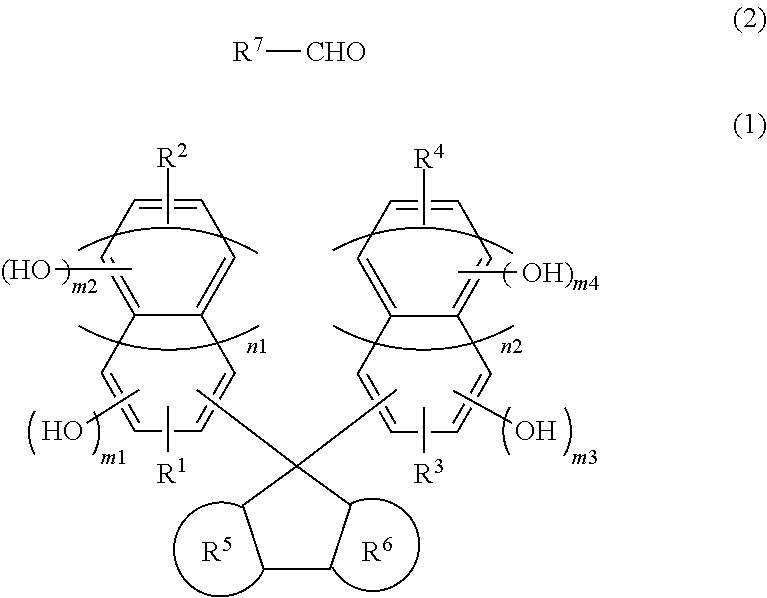Resist underlayer film-forming composition, process for forming resist underlayer film and patterning process
a technology of resist film and composition, which is applied in the direction of photosensitive materials, instruments, photomechanical equipment, etc., can solve the problems of pattern collapse, deterioration of resolution performance of resist film, and failure to accurately transfer resist pattern onto substrate, so as to prevent pattern twisting, enhance etching resistance, and excellent characteristic
- Summary
- Abstract
- Description
- Claims
- Application Information
AI Technical Summary
Benefits of technology
Problems solved by technology
Method used
Image
Examples
synthesis example 1
Resin Synthesis Example 1
Resin (A)-1
[0175]Into a 1-L flask were added 112.5 g of compound (B)-3, 7 g of 37% aqueous formaline solution, 5 g of paratoluenesulfonic acid, 200 g of dioxane, and then they were heated with stirring at 100° C. for 24 hours. After the reaction, the resulting mixture was dissolved in 500 mL of methyl isobutyl ketone, and then washed thoroughly by water to remove a catalyst and metallic impurities. The solvent was removed under reduced pressure, and then water and unreacted monomers were removed by reducing the pressure of the system to 2 mmHg at 150° C. to obtain resin (A)-1.
[0176]Molecular weight (Mw) and dispersivity (Mw / Mn) were obtained from GPC, and a ratio in the polymer was obtained from 1H-NMR analysis. The results are as shown below:
[0177]Resin (A)-1: Mw 5,500, Mw / Mn 4.90
synthesis example 2
Resin Synthesis Example 2
Resin (A)-2
[0178]Into a 1-L flask were added 112.5 g of compound (B)-3, 3.5 g of 37% aqueous formaline solution, 6 g of 2-naphthylaldehyde, 5 g of paratoluenesulfonic acid, 200 g of dioxane, and then they were heated with stirring at 100° C. for 24 hours. After the reaction, the resulting mixture was dissolved in 500 mL of methyl isobutyl ketone, and then washed thoroughly by water to remove a catalyst and metallic impurities. The solvent was removed under reduced pressure, and then water and unreacted monomers were removed by reducing the pressure of the system to 2 mmHg at 150° C. to obtain resin (A)-2.
[0179]Molecular weight (Mw) and dispersivity (Mw / Mn) were obtained from GPC, and a ratio in the polymer was obtained from 1H-NMR analysis. The results are as shown below:
[0180]Resin (A)-2: Mw 5,900, Mw / Mn 5.30
synthesis example 3
Resin Synthesis Example 3
Resin (A)-3
[0181]Into a 300-mL flask were added 50 g of resin (A)-1, 6 g of 9-hydroxymethyl anthracene, 5 g of methane sulfonic acid, 200 g of toluene, and then they were heated with stirring at 120° C. for 2 hours while removing water generated from the reaction. After the reaction, the resulting mixture was dissolved in 500 mL of methyl isobutyl ketone, and then washed thoroughly by water to remove a catalyst and metallic impurities. The solvent was removed under reduced pressure, and then water and unreacted monomers were removed by reducing the pressure of the system to 2 mmHg at 150° C. to obtain resin (A)-3.
[0182]Molecular weight (Mw) and dispersivity (Mw / Mn) were obtained from GPC, and a ratio of components in the polymer was obtained from 1H-NMR analysis. The results are as shown below:
[0183]Resin (A)-3: Mw 6,900, Mw / Mn 4.80
(In the formula, a, b, c and d each represents a mol-ratio and represents a:b=1:1, c:d=3:1)
Preparation of a Resist Underlayer Fi...
PUM
| Property | Measurement | Unit |
|---|---|---|
| Fraction | aaaaa | aaaaa |
| Fraction | aaaaa | aaaaa |
| Temperature | aaaaa | aaaaa |
Abstract
Description
Claims
Application Information
 Login to View More
Login to View More - R&D
- Intellectual Property
- Life Sciences
- Materials
- Tech Scout
- Unparalleled Data Quality
- Higher Quality Content
- 60% Fewer Hallucinations
Browse by: Latest US Patents, China's latest patents, Technical Efficacy Thesaurus, Application Domain, Technology Topic, Popular Technical Reports.
© 2025 PatSnap. All rights reserved.Legal|Privacy policy|Modern Slavery Act Transparency Statement|Sitemap|About US| Contact US: help@patsnap.com



